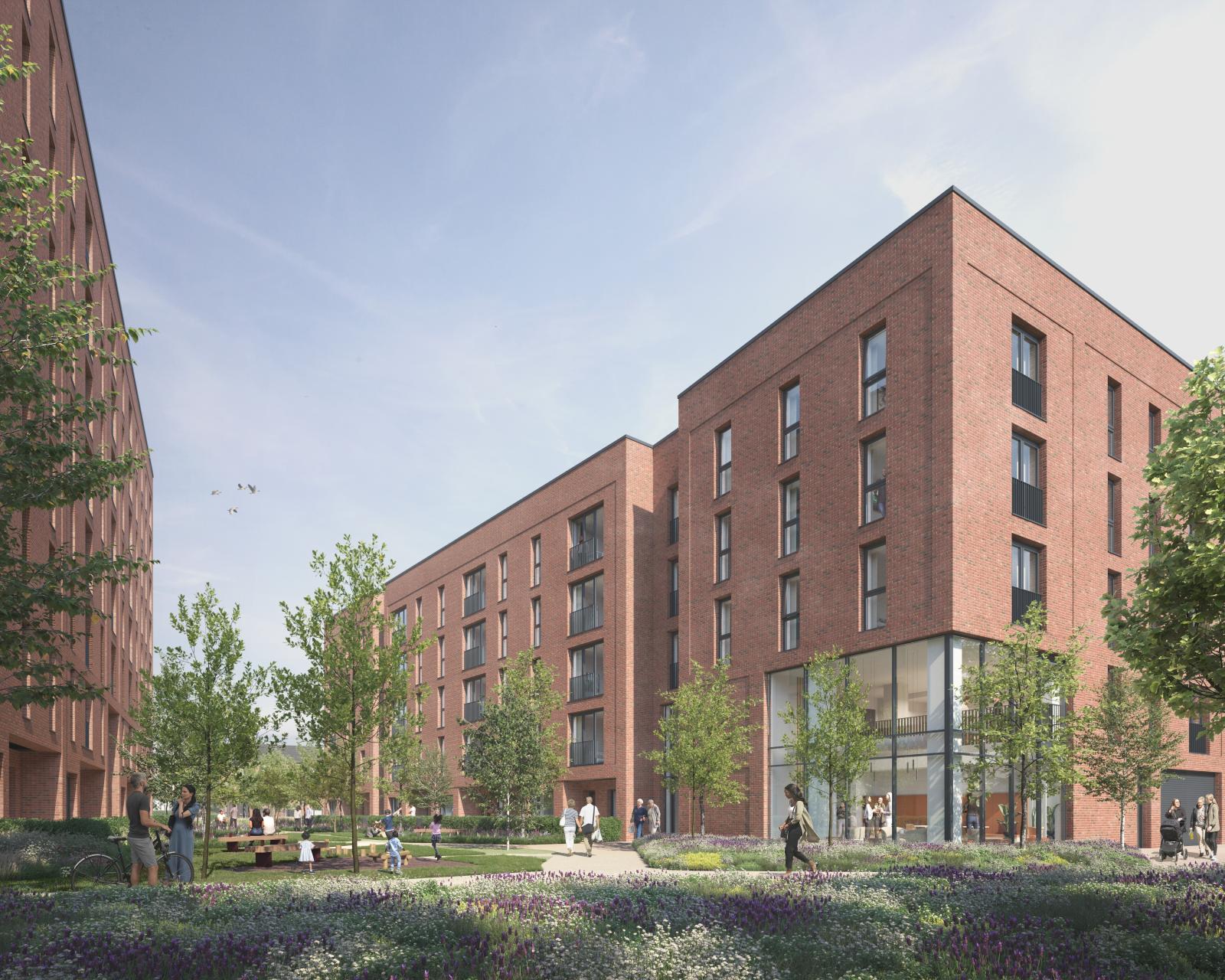
The housing scheme is the first start-on-site for This City, the Manchester Council-owned housing development company.
The development will include 118 apartments across two buildings (a mix of 27 one-bed and 91 two-bed homes), alongside 10 town houses (eight three-bed and two four-bed homes) - and will overlook an improved and expanded Ancoats Green.
A third of the homes will be made available at the Manchester Living Rent, which is capped at the Government’s Local Housing Allowance rate (LHA). This means that these homes will be affordable to residents on full housing benefit and expands the housing offer for people on low incomes in the city centre. The remaining homes will be available at market rent.
This City is bringing long-term brownfield land at Rodney Street in Ancoats back into use, creating high-quality housing in a highly sustainable location, allowing residents to walk, cycle and use nearby public transport to access local services and employment.
Each of the townhouses will include off-street parking with electric vehicle (EV) parking and private gardens to the rear. Seven disabled parking spaces within the development site will also each have an EV charging point.
Parking spaces will also be made available at the nearby Ancoats Mobility Hub alongside bicycle parking.
The Mobility Hub is a new concept in urban design, which centralises car parking for multiple new developments, minimising on-site parking (other than disabled parking) and reduces traffic across the local area, helping to create a pedestrian-first community.
Significant planting and new trees will green the development and complement the wider public realm strategy to make Ancoats a low-carbon, sustainable neighbourhood – focused on active travel rather than the car.
The Rodney Street development will benefit from a wider £32m investment package funded by Homes England in this part of Ancoats, helping to unlock 1,500 new homes and bring the 20-year regeneration story of the area to a close.
This includes major investment in Ancoats Green that borders the This City development site alongside new public realm that will connect the community to the green space, the new Ancoats Mobility Hub, and the surrounding neighbourhoods.
Work to Ancoats Green and the wider public realm will begin later in 2023.

This City
This City is a new development company owned wholly by Manchester City Council. The ambition is to scale up housing development to at least 500 properties each year using Council-owned land to directly build the homes that Manchester people need. At least 20% of these homes will be made available at the Manchester Living Rent.
The company will build a mix of affordable tenures and market rent properties with latter subsidising the cost of the Manchester Living Rent Homes, with the aim of creating diverse, sustainable and long-lasting communities – developing homes that can be accessed by a wide range of Manchester people.
Feasibility studies are already underway for future phases of This City development, with around 1,500 homes in the immediate pipeline.
Cllr Gavin White, Manchester City Council’s executive member for housing and development, said:
“Marking our first start-on-site for This City is a real moment for us. The aim for This City is about using Council-owned land to build the homes that our residents need, that our residents can affordable, in locations they want to live. Rodney Street exemplifies this vision.
“The regeneration journey of Ancoats over the last 20 years has been a remarkable achievement, and this development continues that story, creating low-carbon homes and affordable housing options in the city centre, complemented by quality green space and sustainable transport options.
“The road to building this type of housing is always challenging, particularly in the context of the current economic conditions, but we are proud to celebrate these homes and what they will mean to the Manchester people who live in them.”
Ben Tabiner, associate director of Buttress commented:
“Our approach at Rodney Street is to create a simple and elegant design which responds to its surrounding areas. We’ve worked hard to ensure that the homes have good links with their surrounding areas by positioning the apartment blocks on either side of a new tree-lined and planted street. The green street will create a strong connection across the site and will encourage movement through the area and beyond. The area is also surrounded by original historical streets, and we wanted to reflect this in our designs by opting for a palette of red brickwork in complementary tones.
“Sustainability has also played a significant role in the design with many ecological features being incorporated: such as the buildings being developed in line with the Association for Environment Conscious Building’s (AECB) low carbon standard as well as being fossil fuel free whilst the sun's energy is maximised with the benefits of passive solar design. The combination of mechanical ventilation and heat recovery (MVHR) and heat pump technology will help to keep the energy running costs low for future occupants.”
Dave Saville, Regional managing director for Construction North at Wates, said:
“Rodney Street represents a pioneering shift in development approach for Manchester City Council and we’re proud to support them in their ambitions. We’ve worked closely with our project partners and the Council since the scheme’s inception to carefully plan out how we can ensure Rodney Street delivers its sustainability goals, as well as provides lasting benefit to the wider Ancoats community through Social Value initiatives.
“We have a long history working with councils across the North and beyond on similar residential schemes and the positive impact that considered, sustainable provision of new affordable homes has on an area cannot be underplayed. I applaud Manchester City Council and This City for bringing this development to life and now we’re underway with construction, I and all our teams, look forward to delivering the next milestone.”
The scheme has been designed by Buttress and is being built by Wates, with the main contractor making significant commitments to delivering true Social Value throughout the project.
These include creating 140 weeks of work experience for students, investing £500,000 into local Voluntary Community and Social Enterprises, as well as providing 200 hours of voluntary time to local community projects – which Wates has already delivered nearly twice over.
Image credits
Virtual Planit
Ben Tabiner
Ben is a director at Buttress who is experienced in the design and delivery of projects across a range of sectors, including residential, commercial and education.
Sebastian Drayson
Seb is an associate with experience across a range of sectors, predominantly in the delivery of large, high-quality schemes within the residential and student residential sectors.
At Buttress, he is currently supporting the development of an affordable housing scheme in Ancoats, Manchester.
Paul Wright
Paul is a skilled architect whose experience includes a broad range of residential, commercial and masterplanning projects.


